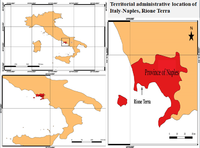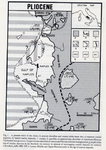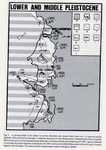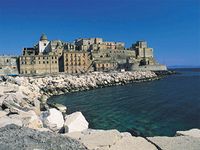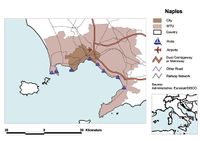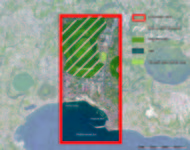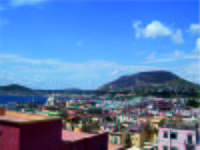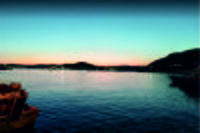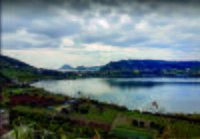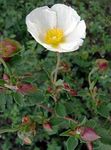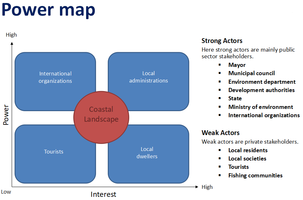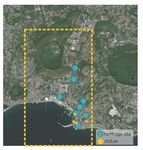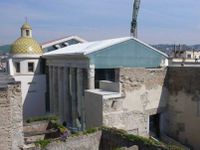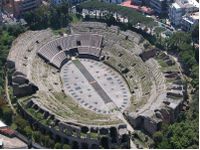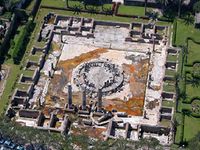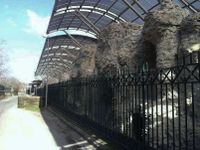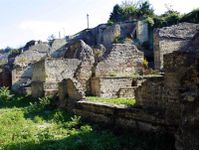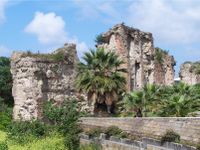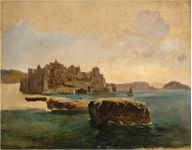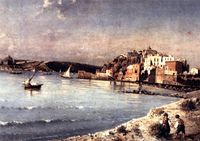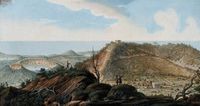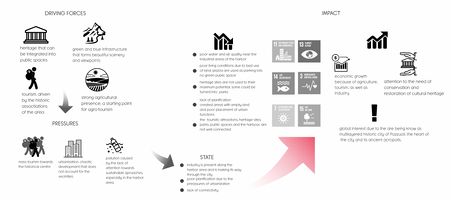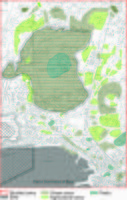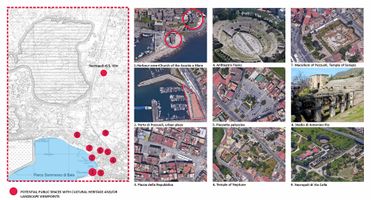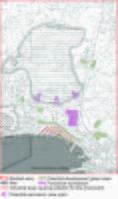Case Study B.2: Rione Terra-Potus Julius
>>>back to working groups overview
Rationale
- The Rione Terra quarter represents the multilayered historic city of Pozzuoli, the heart of the city and its ancient acropolis, and it was founded by the Romans in the 2nd century B.C.
- Rione Terra has been a place of several historical and natural events which brought important changes in the morphology of the Phlegraean Fields, preserving the memory of the past centuries.
- Access to the Mediterranean Sea and the presence of the Gauro Mountain compose the beautiful landscape of this area and favors historical and recreational tourism.
- The volcanic terrain of the area generated fertile soil. This aspect holds great agricultural potential.
- Taking into account the challenges of the area, this impact can put pressure on the natural environment and onto the cultural heritage, to meet the needs of the growing population.
Location and scope
You can edit this map with the map editor
A Landscape System Analysis
A.1 Landscape layers and their system context
Geomorphology, landscape units and coastal typology
Rione Terra is located in the Province of Naples (Italy)(fig.1).
From a geomorphologic point of view, the region is characterized by a graben-like depression.The depression floors are composed by broad alluvional plains.
As a consequence of the tectonics present in this area, after a period of tectonic calm that allowed a mature erosional landscape to develop across the litho-structural complex (in Early Miocene to Middle Pliocene.)(fig.2,fig.3)
Land use
Napoli, being part of Italy, has undergone numerous changes over time. At present, the settlements have remained since ancient times, having numerous medieval monuments, castles, as well as ruins. (fig.4) The underground archaeological Rione Terra is a journey in the ancient Roman colony, Puteoli, was founded in 194 BC and soon became a commercial port.
The course is located below the tuff rock overlooking the Gulf of Pozzuoli, between Nisida and Bay, and runs along the principal axes of the Roman city, cardo and decumani. Today, beneath Rione Terra, there lies a virtually untouched Roman town.
Archaeologists have excavated and restored a four thousand square metre area of the ancient Roman acropolis and its entire underground urban fabric. Now it can be seen the two main arteries of the acropolis flanked by millers’ shops, ancient taverns and the houses of fishermen.
Due to volcanic eruptions, the area became very fertile because of the lava minerals. Agriculture is based on grapes, tomatoes, lemons exotic fruits and native capers. (fig.5)
From the infrastructure point of view, Napoli owns an airport, train lines across the city, buses. Being a port city, transportation can also be done on water. (fig.6)
Green/Blue infrastructure
The studied area has a high potential of development regarding green-blue infrastructure due to the dominant presence in the territory of the Gauro Mountain but also for the access to the Mediterranean Sea.
Gauro Mountain is the volcanic formation with the highest pick it’s a part of the Regional Park situated in the Phlegraean Fields. This area is very important for the ecosystem and it’s also a protected area part of the Natura 2000 Network.
The mountain is an identity element for this zone, with flora and fauna specific for this type of territory and characterized by thick Mediterranean vegetation like chestnut in the north side and plants like cistus[1], mastic trees[2] and myrtle[3] in the steep west side. Also, in the past, in the neighborhood territory of the mountain, was cultivated vines, valuable agriculture areas nowadays.
This important elements of green-blue infrastructure are in a continually changing because of the human intervention and also the urbanization causing in more cases pollution of the environment. We can see this urban development also in the crater of the Mount Gauro, where now is the Carney Park- a recreational facility of the US Navy that can't be visited by other users different of the US Navy stuff. So, because of this limitation, the landscape in this part, from the top of the mountain is not valued as it should be.
Natura 2000 Network prevents this type of intervention in the green protected area, and by improving the green-blue infrastructure in a sustainable manner, the ecosystem will be protected better(marine and mountain biodiversity), reaching a sustainable development of the local economy and also of the urbanization.
Actors and stakeholders
Strong Actors in the Rione Terra-Potus Julius area: Mayor, Municipal council, Environment department, Development authorities, State, Ministry of the environment, International organizations.
Weak actors: Local residents, Local societies, Tourists, Fishing communities.
Here, International organizations have higher authority and they have the liabilities most.
Local authorities have high power and gets affected more because of the locality.
Local dwellers contain less power but have the highest interest and effect.
Tourists have less power and have less stake or effect.
Sacred spaces and heritage
The Rione Terra quarter represents the multilayered historic city of Pozzuoli, the heart of the city and its ancient acropolis, and it was founded by the Romans in the 2nd century B.C. The stratifications and the layers are visible, but under the level of the contemporary city. Following restoration and redevelopment of both the Rione and the archaeological itinerary underlying from the Roman era, from 2014 it was opened to the public.
Which places/elements hold cultural value and to whom?
Rione Terra, being a multilayered historic area, features many well-preserved heritage sites. They hold great value to the locals because they represent the entire history and identity of this culture. They also hold value to the tourists, which are mainly attracted to these beautiful wonders of the past, integrated into the present atmosphere of the city.
- Pozzuoli Cathedral or the Basilica of San Procolo Martire is the main Roman Catholic church in Pozzuoli. The church was first housed in a former Roman temple, the Temple of Augustus built by the rich merchant Lucius Calpurnius. Accelerated bradyseism in 1983-1984 led to the monument being totally abandoned in 1992, leading to vandalism and looting. Finally, the Regione Campania launched an architectural competition for the restoration in July 2003. In the entrance façade, a glass portal reconstructs the colonnade pronaos of the temple; from here, passing by the cell, in which it is possible to see the cuts made in the columns for building the church, the visitor meets the apse part of the Baroque era; the lights in the ceiling recreate the constellations visible in the sky when Saint Paul the Apostle landed in Pozzuoli in 61 AD. Restoration works have respected the marks of the time, keeping them visible, in order to identify the passages from the Roman era to the Renaissance-Baroque, returning to the city a cathedral a little bit different from how it was, but of great impact and deep in history.
- The Flavian Amphitheater is the third largest Roman amphitheater in Italy and it is sharing its name with the most famous of the Roman structures. It was likely built by the same architects who previously constructed the Roman Colosseum and it gives a unique and arguably deeper look into the world of Roman spectacle and gladiatorial combat. In 305, the arena was the setting for the persecutions of the patron of Pozzuoli, Saint Proculus, and the patron saint of Naples, Saint Januarius. Visitors can also go beneath the arena to explore the underground complex below the surface and, in doing so, get a sense of how the amphitheater operated in antiquity.
- Macellum of Pozzuoli was the macellum or market building of the Roman colony of Pozzuoli. When first excavated in the 18th century, the discovery of a statue of Serapis led to the building being misidentified as the city's serapeum or Temple of Serapis. The three standing marble columns indicated that these columns had remained upright over centuries while the site sank below sea level, then re-emerged. This puzzling feature was the subject of debate in early geology and eventually led to the identification of bradyseism in the area, showing that the Earth's crust could be subject to gradual movement without destructive earthquakes.
- The necropolis of San Vito, so-called due to the proximity of one small church dedicated to Saint Vito, is today a forgotten complex, in some ways abandoned and open to a few scholars.
- Necropoli di Via Celle stands out among other necropolis for its majesty. After Rome, Pozzuoli is the city in the world that contains the greatest number of funerary monuments from the Roman era. Like most streets on the outskirts of Roman cities, it was lined with burial grounds, so the Necropolis of Via Celle is undoubtedly the most majestic "cemetery" of the Roman era.
- Stadio di Antonino Pio, unearthed in 2008, was built by emperor Antoninus Pius in honor of the Hellenic spirit of his predecessor Hadrian. The building is located near one of the villas of Cicero, where Adriano was buried after his death in Baia in 138 A. D. This Stadium, hosted a sort of Olympic-type sport event that occurred every five years known by the Greek name of Eusebeia. The stadium was located on via Domitiana (today via Luciano) where it can be admired to this day in all its grandeur. The entire area was buried following the eruption of Monte Nuovo of 1538 while some parts were incorporated in a farmhouse in the 19th century. The modern via Domiziana has cut lengthwise this historical artifact compromising its unity.
- Temple of Neptune: Similarly to Baia, Pozzuoli was famous for its thermal baths with the most famous one being the so-called Temple of Neptune where well-preserved remains can be visited today not far from the Anfiteatro Flavio. The walls were part of the frigidarium, also known as the cold environment while the rear portion of this structure was enriched with a central apse adorned by niches and arches. The rooms arranged on the sides had vaulted ceilings or barrel vaults. The thermal complex must have appeared as an impressive building, visible from the sea, built in the 2nd century A.D. and used until the fourth century A.D.
Visual appearance and landscape narrative
Rione Terra is the first settlement of Pozzuoli. It is placed on a hill, which stands 33 m from the sea. Its position has always been positive to control the arrival of the enemies from the sea and from the land. Unfortunately, due to bradyseisms and especially the earthquake in 1984, Rione Terra was the subject of a great work of retraining and restoration. Finally, it was opened in 2014. Today, this area is very interesting to visit because it is a really overlapping of housing layers.
Through the years, many important people had been inspired by this place. A great example, which is able to summarise the essence, is Alberto Angela's quote. The Italian paleontologist tells:There is a neighborhood where chapters of Pozzuoli's long history are overlapped like the pages of a book.
While, between VIII and IX century A.D., there are some lines written in the Acts of St. Peter and Paul, from the apocryphal Gospel, they justified the sinking of the city to a miracle. It was operated by the apostle Paolo to punish the city where was executed the master of the ship, whit which the saint arrived from Orient. Moreover, also the geographer Strabone, explains his thoughts about. He considered the fortress as the landing of the exiles of the island of Samo, who founded Dicearchia, the government of the correct ones.
Thanks to its suggestive character this area has been also the subject of lots of paintings.
In 1764 G.P.Bollori re-made a painting, which was lost. This one showed the port area and that right there was a temple dedicated to Apollo, it was located on the first acropolis of Pozzuoli.
There are also other views from the nineteenth century, made by Franz Ludwig(1830) and the canvas made by Consalvo Carelli.
A.2 Summary of you landscape system analysis and your development Targets
Landscape System Analysis - DPSI(R) diagram
Rione Terra's driving forces are its heritage, the landscape, and tourism that happens because of it. This creates a great base for economic growth. These driving forces obviously create pressures on the area and so the worst felt effects are mass tourism, urban sprawl, and pollution. This impacts some of the Sustainable Development Goals, such as: 11. Sustainable Cities and Communities, 13. Climate Action, 14. Life Below Water, 3. Good health and well-being, Affordable and Clean Energy, Life on Land. There are then two types of impact on the landscape: a negative one, and a positive one. The negative impact is causing the disturbance of the landscape, pollution of air, water and soil, economic exploitation, and the start of one chaotic urbanization and possible damage to the heritage. On the other hand, there are positive effects such as: the conservation and restoration of the cultural heritage, the possible economic growth that happens because of tourism and global interest for Rione Terra.
Landscape hypothesis
Our hypothesis is that the unsustainable growth and chaotic urbanization are the causes for pollution, destruction of the natural heritage and loss of biodiversity which also leads to a low quality of life. The answer for solving the problems in this scenario is a sustainable development using alternative energy, nature-based sustainable solutions and planfication for the urban development. We thought that other solutions for the problems are to protect nature and the cultural heritage by preserving and restoring it. Also, near the mountain, because of lava minerals from the volcanic eruptions, the soil here is very fertile, and the land has agricultural potential, so we can use this potential in our future development strategy.
A.3 Theory reflection
Plans and policies play a crucial role in understanding the various concepts related to conserving and formulating landscapes. They are not just guiding the users, but also the competent authorities to safeguard the same. Discussing policies at International, European and local level are as followed:
At the International level, the UN HABITAT Planner for Climate Change plays a crucial role in developing the guidelines for the policy that highlights the impact of climate change, at a global and unprecedented scale. It embarks the causes of pollution and how to integrate global measures for the same as an integral part of planning. It is to be applied at different scales, climate-friendly built environment and introducing concepts like participatory planning, green infrastructure, etc.
The second policy or the European policy to be considered is the European Landscape Convention (Florence, 2000) which very basically defines the landscape and the policy as two dependent entities reforming the whole structure of landscape as one. It establishes the concept of human beings at the center of the system thus identifying landscapes and how to protect them.
The third local level policy is the Integrated Coastal Zone Management plan in Italy, in which the plan describes the gap between the scientific community and the people responsible for the formulation of plans, thus depicting the loose control at a national level, thus leaving the regional and lo authorities unguided. It is an interlinked system incorporating all from the stakeholders to the users, thus all these policies should be interlinked.
A.4 References
[2] http://www.napolike.com/tourism/place/district-earth-pozzuoli-napoli/
[3] http://www.pressreader.com
[4] https://www.likealocalguide.com/naples/rione-terra(fig.4)
[5] https://www.flickr.com/groups/napolinobilissima/discuss/72157633306343537/#comment72157635169401115
[6] https://it.wikipedia.org/wiki/Monte_Gauro
[7] http://www.naplesldm.com/gauro.php
[8] Geotechnics and Heritage: Case Histories
[9] http://www.rioneterrapozzuoli.com
[10] http://www.pafleg.it/it/1/home
[11] https://izi.travel/en/italy/city-guides-in-campania-pozzuoli
Phase B: Landscape Evaluation and Assessment
B.1 Assessment Strategy
- Based on the hypothesis derived from your previous landscape systems analysis you are now asked to define the goals for assessing the landscape. Your assessment is the basis for evaluating the landscape status.
- Which elements and phenomena need to be mapped, why and how?
Based on the hypothesis derived from our previous landscape system analysis, we defined some goals that try to gradually improve the status of this area, by using its strengths to deal with the weaknesses.
Our goals are trying to improve the status of tourism, transport infrastructure and of the coastal landscape. We also try to avoid the chaotic development caused by the lack of plannification and uncontrolled tourism.
Therefore, our goals are:
- To create a coherent system that connects the green and blue infrastructure, the heritage and the existing viewpoints that reveal the beautiful landscape.
- To reconnect the city with the harbor/coastal landscape by increasing its attractiveness.
- Smart use of the land. What can we build there?
- Improve transport infrastructure for better accessibility.
- Controlled tourism: What does it mean? How can we do that?
B.2 Mapping
- As defined by your assessment strategy you conduct the mapping and present your findings here
- As a minimum, at least three different themes need to be mapped, you may choose more if needed
The Rione Terra quarter represents the multilayered historic city of Pozzuoli, the heart of the city and its ancient acropolis. There are many heritage sites that have been preserved, in either good or poor condition. At the same time, there are also some plazas where people can find monuments and statues, plazas that hold a certain meaning to the people and that are located in close proximity to the heritage sites. Two of these squares are also located along the harbor area, and they reveal beautiful viewpoint and scenery. We found that many of these places are either abandoned, not well kept, not used to their maximum potential or even turned into parking spaces. Some are not accessible to the public, or lack attractiveness. Some heritage sites, such as the Temple of Neptune, present a great deal of vegetation, so they can be integrated into parks or other kind of green public spaces, even memorial public spaces. They can become great losir places for the people of the city and great touristic attractions, if they are integrated into a green system.
B.3 Problem definition and priority setting
- Give a summary of the major findings of your mapping process, what are the problems/potentials identified?
- From the assessment of the map it can be identified a few major risks or potential risks.
- The connection between humans and the earth generates certain pollutants that negatively influence the surface of the territory. Another factor that affects the area is climate or climate change.
In the illustrated map it can be observed a lot of natural and anthropogenic risks. One natural risk can be earthquakes. In the 1970's the Rione Terra was abandoned due to bradyseismic phenomena that hit the area which was added to the poor health conditions that housed. The bradyseism caused further damage in the 1980's aggravated in the same year by the Irpinia earthquake. Another natural problem is the volcanic eruption remembering about the Pompeii disaster which coverd in lava and ash the entire area. In present Vesuviu Mountain still represents an environmental risk. The coastal zone of Rione Terra is also affected by other natural hazards including flash floods, marine storms and landslides.
- A large contribution to the risk factors are the humans. They're actions affect the environment in the Rione Terra area.
The study area has an opening to the sea and that means that the impact of plastic pollution in the Mediterranean are also being felt across the world and are causing serious harm both to nature and human health. The excessive plastic use, poor waste management and tourism has a large contribution to the damage of the study area. The poor waste management caused by the failure of the government to mandate recycling and waste management program has risen a new type of problem consisting in the waste disposal. Illegal operations regarding the waste disposal are controlled by the Mafia who doesn't follow the right recycling programs and thus produces negative externalities such as health hazards. A last risk to the social environment represents crime which can be described in different ways including sexual violence, fraud and corruption.
- Considering the numerous risks of the area such as the hydro-geological and landslide area, and the many widespread problems on the whole territory due to illegal building, criminality, isolation and degradation of some areas, we have analyzed the position of the affected places and hypothesized that the solution could be to create an inclusive network, removing the areas from isolation and bringing them back to the splendor painted in the Neapolitan guaches, recreating cycle paths already appreciated in Roman times or the Grand Tour.
B.4 Theory reflection
- Please reflect the assessment and evaluation methods used based on at least three readings
- Did you encounter limitations'
- 200 words test contribution
B.5 References
- give a full list of the references you have used for this section
Phase C – Strategy and Master Plan
C.1 Goal Setting
- Define strategic planning objectives based on the evaluation findings
- Link back to your original targets from section one and the Development Goals
- 150 words text contribution
C.2 Spatial Strategy and Transect
- translate your strategic goals into a vision
- develop a spatial translation of your vision
- exemplify your vision in the form of a transect with concrete interventions
- add map(s) and visualizations
- Your case spatial translaton vision.jpg
add caption here
- Your case transect.jpg
add caption here
- Your case transect detail1.jpg
add caption here
- Your case transect detail2.jpg
add caption here
C.3 From Theory of Change to Implementation
- For implementing your vision: Which partnerships are needed? Which governance model is required?
- Who needs to act and how? Draw and explain a change/process model/timeline
- Which resources are needed? On which assets can you build?
- add 150 words text and visuals
- Your case spatial your governance model.jpg
add caption here
- Your case spatial your process model.jpg
add caption here
C.4 References
- give a full list of the references you have used for this section
D. Process Reflection
- Reflect in your intercultural and interdisciplinary team on the outcomes of your study
- Which limitations were you facing?
- What have you learnt from each other?
- What would you do differently next time?
- You can also use diagrams/visuals
- 250 words text

